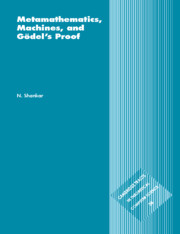2 - The Statement of the Incompleteness Theorem
Published online by Cambridge University Press: 16 October 2009
Summary
It is well known that the development of mathematics in the direction of greater precision has led to the formalization of xtensive mathematical domains, in the sense that proofs can be carried out according to a few mechanical rules.
Kurt Gödel [Göd67b]Thus began Gödel's 1931 paper [Göd67b] in which he demonstrated the existence of formally undecidable sentences in a wide class of formal systems. The first part of this book describes a formalization and proof of this theorem that was carried out according to a “few mechanical rules.” The proof here is not a direct mechanization of any particular previously published version of the incompleteness proof. The statement of the theorem differs from Gödel's original statement which involved the notion of w-consistency. The statement here only involves the weaker notion of consistency and this form of the theorem was first proved by Rosser [Ros36]. The theorem we establish asserts the incompleteness of cohen's Z2 [Coh66]. The first-order logic of Z2 is taken from that of Shoenfield [Sho67]. Various metatheorems about Z2 are formalized and proved using the Boyer–Moore theorem prover.
This chapter presents a complete description of the formal statement of the incompleteness theorem. The main part of this description is the definition of the metatheory of Z2 in terms of a Lisp representation for the formulas and proofs of Z2, and a Lisp predicate that checks the validity of Z2 proofs represented in this manner. The representation of the symbols (variables, functions, predicates) and expressions (terms, atomic formulas, negation, disjunction, quantification) is first described. Various operations are defined for checking the well-formedness of expressions along with the important operation of substitution.
- Type
- Chapter
- Information
- Metamathematics, Machines and Gödel's Proof , pp. 35 - 70Publisher: Cambridge University PressPrint publication year: 1994



